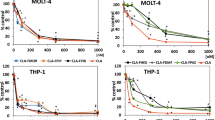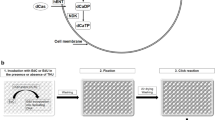Abstract
6-Mercaptopurine (MP)-sensitive and -resistant cell culture lines were used to further characterize the apparent ability of MP nucleotide derivatives to overcome resistance to the parent drug. 6-Mercaptopurine-9-beta-D-ribofuranoside 5'-monophosphate [MPRP], bis(6-mercaptopurine-9-beta-D-ribofuranoside)-5', 5"'-monophosphate [bis(MPR)P], bis(O2',O3'-dibutyryl-6-mercaptopurine-9-beta-D-ribofuranoside)-5', 5"'-monophosphate [bis(dibut.MPR)P], and O2',O3'-dibutyryl-6-mercaptopurine-9-beta-D-ribofuranoside 5'-monophosphate [dibut.MPRP] were tested for cytotoxic and/or growth inhibitory effects against MP-resistant sublines of V79 Chinese hamster lung fibroblasts (CH/TG) and L1210 mouse leukaemia cells (L1210/MPR) in which deficiencies of hypoxanthine-guanine phosphoribosyltransferase, and hence drug nucleotide forming capacity were the basis of resistance. L1210/MPR cells were totally resistant to 1 mM 6-mercaptopurine-9-beta-D-ribofuranoside [MPR] and 2 mM MPRP, but were inhibited by high concentrations (greater than 0.25 mM) of bis(MPR)P. These results suggested that bis(MPR)P was taken up by cells as the intact molecule since MPR and MPRP were its extracellular breakdown products. L1210/MPR cells were much more sensitive to the lipophilic bis(dibut.MPR)P derivative which had a predominantly cytotoxic action as judged by trypan blue staining and the ability of treated cells to produce macroscopic colonies in soft agar medium. However, cells killed by bis(dibut.MPR)P did not disintegrate appreciably over periods of up to 10 days. The effects of bis(dibut.MPR)P were probably the result of cellular uptake of the intact molecule. Dibut.MPRP showed minimal ability to inhibit L1210/MPR cells although this compound was a possible breakdown product of bis(dibut.MPR)P and a source of the same extracellular degradation products. The median cell size decreased in L1210/MPR cultures during exposure to both bis(MPR)P and bis(dibut.MPR)P. This effect was elicited more rapidly and at lower concentration by bis(dibut.MPR)P than by bis(MPR)P. In contrast, sodium butyrate, a breakdown product of bis(dibut.MPR)P induced increases in cell size at high concentration. Bis (dibut.MPR)P was also cytotoxic to MP-resistant CH/TG cells and was approximately 300 times more effective than bis(MRP)P and MPR which exhibited similar activity against this cell line. Bis(dibut.MPR)P and dibut.MPRP were equivalent and less active than MPR in their effects on MP-sensitive L1210/0 cells where their predominant mechanism of action was via degradation to release MPR.(ABSTRACT TRUNCATED AT 400 WORDS)
This is a preview of subscription content, access via your institution
Access options
Subscribe to this journal
Receive 24 print issues and online access
$259.00 per year
only $10.79 per issue
Buy this article
- Purchase on Springer Link
- Instant access to full article PDF
Prices may be subject to local taxes which are calculated during checkout
Similar content being viewed by others
Rights and permissions
About this article
Cite this article
Johnston, H., Hawley, P., White, S. et al. The effects of 6-mercaptopurine nucleotide derivatives on the growth and survival of 6-mercaptopurine-sensitive and -resistant cell culture lines. Br J Cancer 51, 505–514 (1985). https://doi.org/10.1038/bjc.1985.73
Issue Date:
DOI: https://doi.org/10.1038/bjc.1985.73



